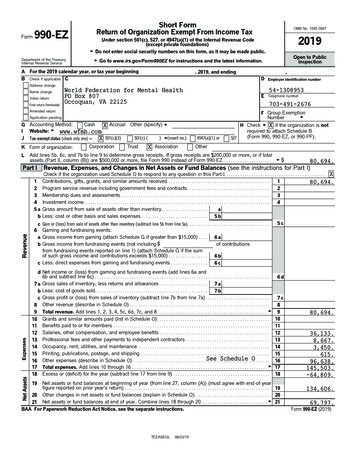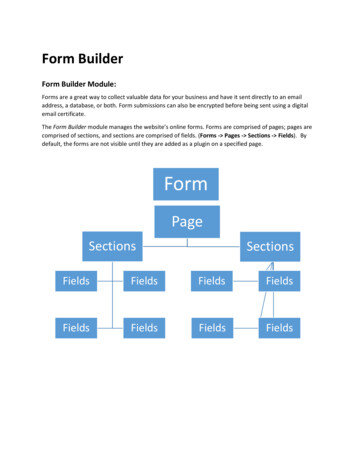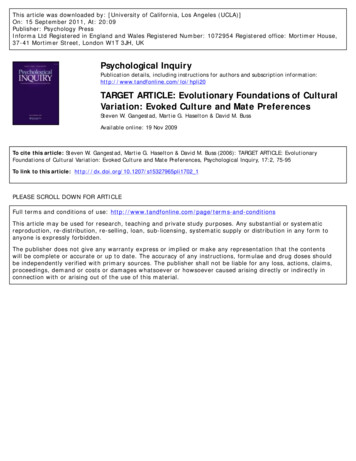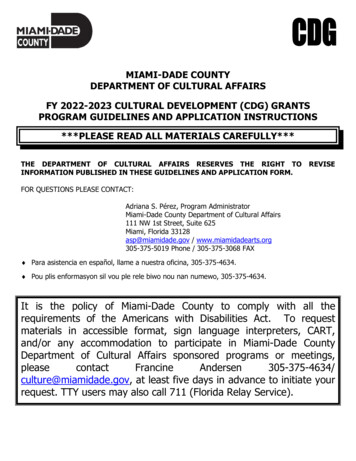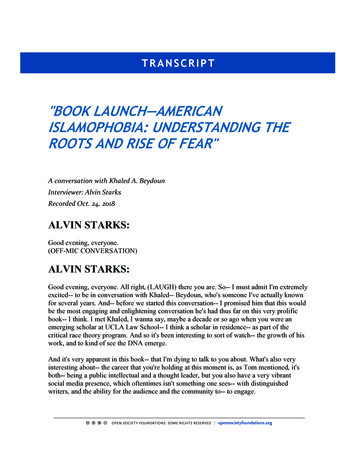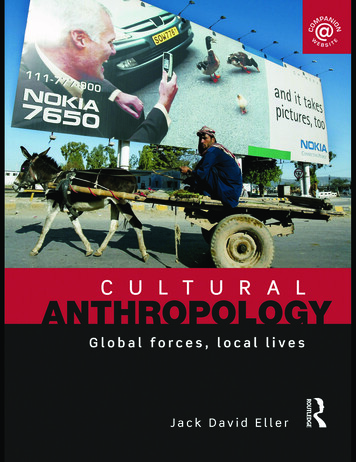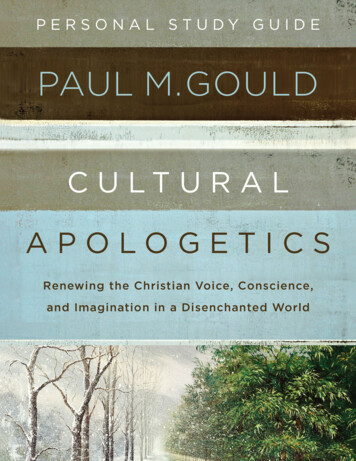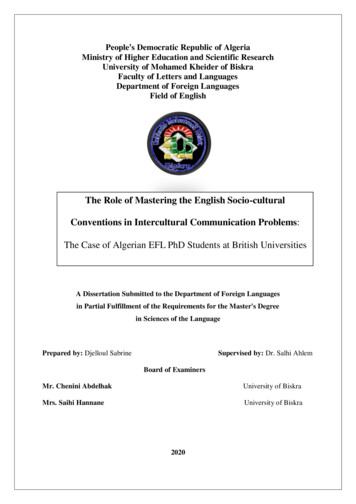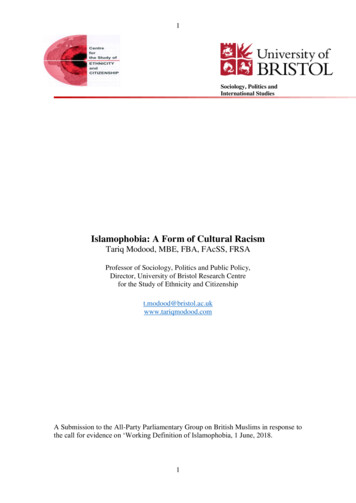
Transcription
1Sociology, Politics andInternational StudiesIslamophobia: A Form of Cultural RacismTariq Modood, MBE, FBA, FAcSS, FRSAProfessor of Sociology, Politics and Public Policy,Director, University of Bristol Research Centrefor the Study of Ethnicity and omA Submission to the All-Party Parliamentary Group on British Muslims in response tothe call for evidence on ‘Working Definition of Islamophobia, 1 June, 2018.1
2Proposed Working Definition of Islamophobia:Islamophobia is the racialising of Muslims based on physical appearance or descentas members of a community and attributing to them cultural or religiouscharacteristics to vilify, marginalise, discriminate or demand assimilation andthereby treat them as second class citizens.It was not very long ago that Anglophone scholars of racism understood it in terms ofbiology, and specifically in terms of the black-white binary. At the same time, otherscholars, especially in continental Europe, understood racism in terms of antisemitism, especially in the recent biologised forms that Europe has manifested. Whenit began to be clear that these two paradigms were failing to capture somecontemporary experiences, such as anti-Asian cultural racism in Britain or anti-Arabcultural racism in France, some scholars began to move away from these paradigms.1Yet, following the assertive Muslim agency triggered off by The Satanic Verses affairand other Muslim controversies, as Muslims responded to such hostilities andarticulated their misrecognition, they were constantly told, especially in Britain, thatthere is no such thing as anti-Muslim racism because Muslims are a religious groupand not a race. Hence Muslims could legitimately ask for toleration and religiouspluralism but not for inclusion in anti-racist egalitarian analyses and initiatives. Whilethis view continues to be expressed even today, and some deny that there is a racismthat could be labelled ‘Islamophobia’, it no longer has the hegemony it once had.While a number of Anglophone authors, including myself, started using the conceptof Islamophobia in the late 1980s and early 1990s, it was the Runnymede Trust, withits 1997 report, ‘Islamophobia: a challenge to us all’, which launched the career ofthe term as a concept of public discourse in Britain and much beyond it. It presentedIslamophobia as ‘a useful shorthand way of referring to dread or fear of Islam – andtherefore to fear or dislike of all or most Muslims’. While the report was groundbreaking and played a crucial role in getting people to think about anti-Muslimprejudice I felt it did not sufficiently locate Islamophobia as a racism, like say, antisemitism. I continued to write about Islamophobia as a form of cultural racism, whichmay be built on racism based on physical appearance (eg., colour-racism) but was aform of racism in its own right – like anti-semitism.2 This also became the approachof UNESCO and I am pleased to see that it has been explicitly embraced by the newRunnymede Trust report of November, 2017.Islamophobia is a form of cultural racism because while the perception and treatmentof Muslims clearly has a religious and cultural dimension it, equally clearly, bears aphysical appearance or ancestral component. For while it is true that ‘Muslim’ is nota (putative) biological category in the way that ‘black’ or ‘south Asian’ (aka ‘Paki’),or Chinese is, neither was ‘Jew’. In that instance it took a long non-linear history ofracialisation to turn an ethno-religious group into a race. More precisely, the latter didnot so much as replace the former but superimposed itself because even though noone denied that Jews were a religious community, with a distinctive language(s),culture(s) and religion, Jews still came to be seen as a race, and with horrific1Introduction and Chapter 1 in Modood, T, Multicultural Politics: Racism, Ethnicity and Muslims inBritain, Edinburgh, 2005.2Modood, 2005, Intro and chp 1; N. Meer and T. Modood, ‘For ‘’Jewish’’ Read ‘’Muslim’’?Islamophobia as a Form of Racialisation of Ethno-Religious Groups in Britain Today’, IslamophobiaStudies Journal, 1(1), Spring 2012: 36-55.2
3consequences. Similarly, Bosnian Muslims were ‘ethnically cleansed’ because theycame to be identified as a ‘racial’ group, that is to say, as having a perceived line ofdescent by people who actually were phenotypically, linguistically and culturally thesame as themselves. The ethnic cleanser, unlike an Inquistor, wasted no time infinding out what people believed, if and how often they went to a mosque and so on:their victims were racially identified as Muslims in terms of community membershipbased on a perceived line of descent.Race, then, as I understand it is not just about biology or even ‘colour’, for whileracialization has to pick on some features of a people related to physical appearanceand ancestry (otherwise racism cannot be distinguished from other forms ofgroupism) it need only be a marker. This is illustrated in the conceptualisation ofcultural racism as what I have called a two step process.3 While biological racism isthe antipathy, exclusion and unequal treatment of people on the basis of their physicalappearance or other imputed physical differences, saliently in Britain their non'whiteness', cultural racism builds on biological racism a further discourse whichevokes cultural differences from an alleged British, 'civilised' norm to vilify,marginalise or demand cultural assimilation from groups who may also suffer frombiological racism. As white people's interactions with non-white individualsincreased, they did not become necessarily less conscious of group differences butthey were far more likely to ascribe group differences to upbringing, customs, formsof socialisation and self-identity than to biological heredity.Cultures and cultural practices are usually internally diverse, containing and omittingvarious “authentic” elements, and adaptations and mixes. So to racially group allJews or Muslims together as one cultural ‘race’ or as one ethnoreligious entity, itfollows that the culturalized targeting is expansive, rather than purist, aiming to catchmost if not all cultural minorities in that targeted group. For example, a non-religiousMuslim might still be targeted as a cultural Muslim or Muslim by community, whichof course means Muslim by background, which means birth and ancestry. Hence mypoint that Muslims, no less than Jews, are identified ‘racially’ and not simply in termsof religious beliefs or behaviour. Moreover, if we accept that racism does notnecessarily involve attributing qualities which inhere in a deterministic law-like wayin all members of a group, then we do not have to rule out cultural racism as anexample of racism. As such we should guard against the characterisation of racism asa form of biological determinism which leaves little space to conceive the ways inwhich cultural racism draws upon physical appearance as one marker amongstothers.4Danger of Reducing Muslims to IslamophobiaWhile understanding some contemporary treatment of Muslims and aspects of theirsocietal status in terms of ‘racialisation’ clearly is an advance, we should beware thatthe conceptualisation of Muslims in the West is not reduced to racialisation or anyother ‘Othering’ theoretical frame such as Orientalism. By definition ‘othering’ sees aminority in terms of how a dominant group negatively and stereotypically imaginesthat minority as something ‘other’, as inferior or threatening, and to be excluded.Indeed, the dominant group typically projects its own fears and anxieties on to the34Modood, 2005, Intro and chp 1Modood, 2005, Intro and chp 13
4minority. Minorities, however, are never merely ‘projections' of dominant groups buthave their own subjectivity and agency through which they challenge how they are(mis)perceived and seek to not be defined by others but to supplant negative andexclusionary stereotypes with positive and prideful identities. Oppressivemisrecognitions, thus, sociologically imply and politically demand recognition. Ouranalyses therefore should be framed in terms of a struggle for ‘recognition’ – therecognition of one’s own identity.5The danger of reducing Muslims to racialised identities is particularly high at themoment because the Islamophobic ‘othering’ of Muslims is acute, and if anything,rising. This can be seen in how aggressive negative portrayals of Muslims is standardin so much rightwing nationalism, whether in President Trump’s Muslim bans,Marine Le Pen’s Front National, Alternative fur Deustschland in Germany or invarious parties in central and eastern Europe. I do worry, however, that just as in the1970s and 1980s some anti-racists, including academics, reduced blackness to a formof anti-racism, anti-Islamophobia activism and studies risks seeing Muslims only interms of racialisation and anti-racialisation. Because like all ethnic or religious groupsMuslims are not merely created by their oppressors but have their own sense ofidentity too. Multicultural inclusivity means recognising and respecting theseidentities.Recognition of course does not mean thinking of Muslims as a group with uniformattributes or a single mind-set, all having the same view on religion, personalmorality, politics, the international world order and so on. Muslims are just like anyother group – they cannot be understood in terms of a single essence. Groups do nothave discrete, nor indeed, fixed boundaries as these boundaries may vary across timeand place, across social contexts and will be the subject of social construction andsocial change – and Muslims are no different in this respect. This ‘anti-essentialism’is rightly deployed in the study of Islamophobia and Muslims. It is a powerful way ofhandling ascriptive discourses, of showing that various popular or dominant ideasabout Muslims, just as in the case of, say, women, gays etc, are not true as such butare aspects of socially constructed images that have been made to stick on to thosegroups of people because the ascribers are more powerful than the ascribed. Antiessentialism is an intellectually compelling idea and a powerful resource in the causeof equality.Reasonable CriticismMerely identifying the unreasonable and the populist, however, is not enough; ourframes of analysis should lead us to the reasonable, to what criticisms may be made ofMuslims and/or Islam and what criticisms that Muslims want to make ofcontemporary western societies too are worthy of hearing.How, however, are we to distinguish reasonable criticism from Islamophobia? Takethe proposition:‘Muslim views about women are oppressive and not appropriate for modern Britain’.Is this Islamophobia or reasonable criticism?T. Modood, ‘Islamophobia and the Muslim Struggle for Recognition’ in Islamophobia: Still aChallenge for us All, Runnymede Trust, 2017: 66-68.54
5My suggestion is that we should apply the following five tests:1. Does it stereotype Muslims by assuming they all think the same?- Does the criticism(s) seem to suggest that all or most Muslims have thisblameworthy characteristic and that this feature defines Muslims, indeeddrowns out any worthy characteristics and ignores contextual factors?2. Is it about Muslims or a dialogue with Muslims, which they would wish tojoin in?- Does the mode of criticism consist of generalising about a group in a way that tendsto exclude them rather than treat them as conversational partners who share commonconcerns?3. Is mutual learning possible?- For example, one may criticise some Muslims for sexual conservatism or puritanismbut is one willing to listen to those Muslims who think that contemporary societieslike Britain are over-sexualised and encourage sexually predatory and undignifiedbehaviour?64. Is the language civil and contextually appropriate?- Is the behaviour or practice being criticised in an offensive way and seems to makeMuslims the target rather than stick to the issue? (A good analogy is here is howreasonable, contextual criticism of Zionsim can become a diatribe against Jewishpeople as such.)5. Insincere criticism for ulterior motives?- Does the person doing the criticism really care about the issue or is using it to attackMuslims (in the way that many use feminism and homosexuality)?If the answer to any of the five is a ‘Yes’ then we may be dealing with Islamophobiaor anti-Muslim racism.ConclusionProposed Working Definition of Islamophobia, which may not capture everythingmeant by ‘Islamophobia’ but which captures the core features of the contemporaryphenomena for Muslims in Britain:Islamophobia is the racialising of Muslims based on physical appearance or descentas members of a community and attributing to them cultural or religiouscharacteristics to vilify, marginalise, discriminate or demand assimilation andthereby treat them as second class citizens.6In the post-Harvey Weinstein and #MeToo climate it might be easier to understand the point here thanit might have been a few years ago.5
6ReferencesIntroduction and Chapter 1 in Modood, T. Multicultural Politics: Racism, Ethnicity andMuslims in Britain, Edinburgh, 2005.‘Islamophobia and the Muslim Struggle for Recognition’ in Islamophobia: Still a Challengefor us All, Runnymede Trust, 2017: 66-68, T. Modood.‘For ‘’Jewish’’ Read ‘’Muslim’’? Islamophobia as a Form of Racialisation of Ethno-ReligiousGroups in Britain Today’, Islamophobia Studies Journal, 1(1), Spring 2012: 36-55; N. Meerand T. 1/8/21/236195 754.pdf6
Tariq Modood, MBE, FBA, FAcSS, FRSA Professor of Sociology, Politics and Public Policy, Director, University of Bristol Research Centre for the Study of Ethnicity and Citizenship t.modood@bristol.ac.uk www.tariqmodood.com A Submission to the All-Party Parliamentary Group on British Muslims in response to
